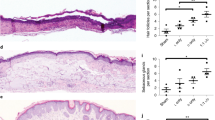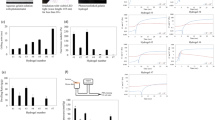Abstract
Injectable hydrogels can provide a scaffold for in situ tissue regrowth and regeneration, yet gel degradation before tissue reformation limits the gels’ ability to provide physical support. Here, we show that this shortcoming can be circumvented through an injectable, interconnected microporous gel scaffold assembled from annealed microgel building blocks whose chemical and physical properties can be tailored by microfluidic fabrication. In vitro, cells incorporated during scaffold formation proliferated and formed extensive three-dimensional networks within 48 h. In vivo, the scaffolds facilitated cell migration that resulted in rapid cutaneous-tissue regeneration and tissue-structure formation within five days. The combination of microporosity and injectability of these annealed gel scaffolds should enable novel routes to tissue regeneration and formation in vivo.
This is a preview of subscription content, access via your institution
Access options
Subscribe to this journal
Receive 12 print issues and online access
$259.00 per year
only $21.58 per issue
Buy this article
- Purchase on Springer Link
- Instant access to full article PDF
Prices may be subject to local taxes which are calculated during checkout






Similar content being viewed by others
References
Lee, K. & Hubbell, J. A. Tissue, cell and engineering. Curr. Opin. Biotechnol. 24, 827–829 (2013).
Guvendiren, M. & Burdick, J. A. Engineering synthetic hydrogel microenvironments to instruct stem cells. Curr. Opin. Biotechnol. 24, 841–846 (2013).
Discher, D. E., Mooney, D. J. & Zandstra, P. W. Growth factors, matrices, and forces combine and control stem cells. Science 324, 1673–1677 (2009).
Huebsch, N. et al. Harnessing traction-mediated manipulation of the cell/matrix interface to control stem-cell fate. Nature Mater. 9, 518–526 (2010).
Wade, R. J. & Burdick, J. A. Engineering ECM signals into biomaterials. Mater. Today 15, 454–459 (October, 2012).
Alijotas-Reig, J., Fernández-Figueras, M. T. & Puig, L. Late-onset inflammatory adverse reactions related to soft tissue filler injections. Clin. Rev. Allergy Immunol. 45, 97–108 (2013).
Lutolf, M. P. et al. Synthetic matrix metalloproteinase-sensitive hydrogels for the conduction of tissue regeneration: Engineering cell-invasion characteristics. Proc. Natl Acad. Sci. USA 100, 5413–5418 (2003).
Galler, K. M., Aulisa, L., Regan, K. R., D’Souza, R. N. & Hartgerink, J. D. Self-assembling multidomain peptide hydrogels: Designed susceptibility to enzymatic cleavage allows enhanced cell migration and spreading. J. Am. Chem. Soc. 132, 3217–3223 (2010).
Wang, D-A. et al. Multifunctional chondroitin sulphate for cartilage tissue–biomaterial integration. Nature Mater. 6, 385–392 (2007).
Kong, H. J., Kaigler, D., Kim, K. & Mooney, D. J. Controlling rigidity and degradation of alginate hydrogels via molecular weight distribution. Biomacromolecules 5, 1720–1727 (2004).
Burdick, J. A., Chung, C., Jia, X., Randolph, M. A. & Langer, R. Controlled degradation and mechanical behavior of photopolymerized hyaluronic acid networks. Biomacromolecules 6, 386–391 (2005).
Madden, L. R. et al. Proangiogenic scaffolds as functional templates for cardiac tissue engineering. Proc. Natl Acad. Sci. USA 107, 15211–15216 (2010).
Stachowiak, A. N., Bershteyn, A., Tzatzalos, E. & Irvine, D. J. Bioactive hydrogels with an ordered cellular structure combine interconnected macroporosity and robust mechanical properties. Adv. Mater. 17, 399–403 (2005).
Gorgieva, S. & Kokol, V. Preparation, characterization, and in vitro enzymatic degradation of chitosan-gelatine hydrogel scaffolds as potential biomaterials. J. Biomed. Mater. Res. A 100, 1655–1667 (2012).
Sokic, S., Christenson, M., Larson, J. & Papavasiliou, G. In situ generation of cell-laden porous MMP-sensitive PEGDA hydrogels by gelatin leaching. Macromol. Biosci. 14, 731–739 (2014).
Hosokawa, K., Fujii, T. & Endo, I. Handling of picoliter liquid samples in a poly(dimethylsiloxane)-based microfluidic device. Anal. Chem. 71, 4781–4785 (1999).
Anna, S. L., Bontoux, N. & Stone, H. A. Formation of dispersions using ‘flow focusing’ in microchannels. Appl. Phys. Lett. 82, 364–366 (2003).
Kawakatsu, T., Kikuchi, Y. & Nakajima, M. Regular-sized cell creation in microchannel emulsification by visual microprocessing method. J. Am. Oil Chem. Soc. 74, 317–321 (1997).
Li, C. Y., Wood, D. K., Hsu, C. M. & Bhatia, S. N. DNA-templated assembly of droplet-derived PEG microtissues. Lab Chip 11, 2967–2975 (2011).
Du, Y., Lo, E., Ali, S. & Khademhosseini, A. Directed assembly of cell-laden microgels for fabrication of 3D tissue constructs. Proc. Natl Acad. Sci. USA 105, 9522–9527 (2008).
Qi, H. et al. DNA-directed self-assembly of shape-controlled hydrogels. Nature Commun. 4, 2275 (2013).
Jgamadze, D. et al. Colloids as mobile substrates for the implantation and integration of differentiated neurons into the mammalian brain. PLoS ONE 7, e30293 (2012).
Pautot, S., Wyart, C. & Isacoff, E. Y. Colloid-guided assembly of oriented 3D neuronal networks. Nature Methods 5, 735–740 (2008).
Dunne, M., Corrigan, O. I. & Ramtoola, Z. Influence of particle size and dissolution conditions on the degradation properties of polylactide-co-glycolide particles. Biomaterials 21, 1659–1668 (2000).
Chen, H. et al. Hydrogel-thickened microemulsion for topical administration of drug molecule at an extremely low concentration. Int. J. Pharm. 341, 78–84 (2007).
Conchouso, D., Castro, D., Khan, S. A. & Foulds, I. G. Three-dimensional parallelization of microfluidic droplet generators for a litre per hour volume production of single emulsions. Lab Chip 14, 3011–3020 (2014).
Griffin, D. R. et al. Hybrid photopatterned enzymatic reaction (HyPER) for in situ cell manipulation. ChemBioChem 15, 233–242 (2014).
Schense, J. C. & Hubbell, J. A. Cross-linking exogenous bifunctional peptides into fibrin gels with factor XIIIa. Bioconjug. Chem. 10, 75–81 (1999).
Lutolf, M. P. & Hubbell, J. A. Synthetic biomaterials as instructive extracellular microenvironments for morphogenesis in tissue engineering. Nature Biotechnol. 23, 47–55 (2005).
Chen, E. J., Novakofski, J., Jenkins, W. K. & O’Brien, J. W. D. Young’s modulus measurements of soft tissues with application to elasticity imaging. IEEE Trans. Ultrason. Ferroelectr. Freq. Control 43, 191–194 (1996).
Cheng, S. & Bilston, L. E. Unconfined compression of white matter. J. Biomech. 40, 117–124 (2007).
Parker, K. J., Huang, S. R., Musulin, R. A. & Lerner, R. M. Tissue response to mechanical vibrations for ‘sonoelasticity imaging’. Ultrasound Med. Biol. 16, 241–246 (1990).
Samani, A., Bishop, J., Luginbuhl, C. & Plewes, D. B. Measuring the elastic modulus of ex vivo small tissue samples. Phys. Med. Biol. 48, 2183–2198 (2003).
Yeh, W-C. et al. Elastic modulus measurements of human liver and correlation with pathology. Ultrasound Med. Biol. 28, 467–474 (2002).
Galiano, R. D., Michaels, J., Dobryansky, M., Levine, J. P. & Gurtner, G. C. Quantitative and reproducible murine model of excisional wound healing. Wound Repair Regen. 12, 485–492 (2004).
Fukano, Y. et al. Characterization of an in vitro model for evaluating the interface between skin and percutaneous biomaterials. Wound Repair Regen. 14, 484–491 (2006).
Fukano, Y. et al. Epidermal and dermal integration into sphere-templated porous poly(2-hydroxyethyl methacrylate) implants in mice. J. Biomed. Mater. Res. A 94A, 1172–1186 (2010).
Wang, H-M. et al. Novel biodegradable porous scaffold applied to skin regeneration. PLoS ONE 8, e56330 (2013).
Wang, X., Ge, J., Tredget, E. E. & Wu, Y. The mouse excisional wound splinting model, including applications for stem cell transplantation. Nature Protoc. 8, 302–309 (2013).
Ota, T. et al. Notch signaling may be involved in the abnormal differentiation of epidermal keratinocytes in psoriasis. Acta Histochem. Cytochem. 47, 175–183 (2014).
Bramfeld, H., Sabra, G., Centis, V. & Vermette, P. Scaffold vascularization: A challenge for three-dimensional tissue engineering. Curr. Med. Chem. 17, 3944–3967 (2010).
Hollister, S. J. Porous scaffold design for tissue engineering. Nature Mater. 4, 518–524 (2005).
Yang, S., Leong, K-F., Du, Z. & Chua, C-K. The design of scaffolds for use in tissue engineering. Part I. Traditional factors. Tissue Eng. 7, 679–689 (2001).
Peters, M. C., Polverini, P. J. & Mooney, D. J. Engineering vascular networks in porous polymer matrices. J. Biomed. Mater. Res. 60, 668–678 (2002).
Winkler, E. A., Bell, R. D. & Zlokovic, B. V. Pericyte-specific expression of PDGFβ receptor in mouse models with normal and deficient PDGFβ receptor signaling. Mol. Neurodegener. 5, 32 (2010).
Huang, F-J. et al. Pericyte deficiencies lead to aberrant tumor vascularizaton in the brain of the NG2 null mouse. Dev. Biol. 344, 1035–1046 (2010).
Stratman, A. N., Malotte, K. M., Mahan, R. D., Davis, M. J. & Davis, G. E. Pericyte recruitment during vasculogenic tube assembly stimulates endothelial basement membrane matrix formation. Blood 114, 5091–5101 (2009).
Rustad, K. C. et al. Enhancement of mesenchymal stem cell angiogenic capacity and stemness by a biomimetic hydrogel scaffold. Biomaterials 33, 80–90 (2012).
Richardson, T. P., Peters, M. C., Ennett, A. B. & Mooney, D. J. Polymeric system for dual growth factor delivery. Nature Biotechnol. 19, 1029–1034 (2001).
Sun, G. et al. Dextran hydrogel scaffolds enhance angiogenic responses and promote complete skin regeneration during burn wound healing. Proc. Natl Acad. Sci. USA 108, 20976–20981 (2011).
Tokatlian, T., Cam, C. & Segura, T. Porous hyaluronic acid hydrogels for localized nonviral DNA delivery in a diabetic wound healing model. Adv. Healthc. Mater. (2015) 10.1002/adhm.201400783
Liang, W. et al. Metabolically induced liver inflammation leads to NASH and differs from LPS- or IL-1β-induced chronic inflammation. Lab. Invest. 94, 491–502 (2014).
Latger-Cannard, V., Besson, I., Doco-Lecompte, T. & Lecompte, T. A standardized procedure for quantitation of CD11b on polymorphonuclear neutrophil by flow cytometry: Potential application in infectious diseases. Clin. Lab. Haematol. 26, 177–186 (2004).
Lucas, T. et al. Differential roles of macrophages in diverse phases of skin repair. J. Immunol. 184, 3964–3977 (2010).
Acknowledgements
The authors would like to thank A. Vucetic for assistance with gelation-kinetics measurements. This work was partially supported through the US National Institutes of Health Director’s New Innovator Award (1DP2OD007113), NIH RO1HL110592, and the DermSTP Training Grant T32-AR058921.
Author information
Authors and Affiliations
Contributions
D.R.G. and W.M.W. contributed equally to this manuscript, both in conceptual design, troubleshooting, experimental execution and manuscript writing. P.O.S. performed Day 1 immunological analysis and in vivo interpretation. D.D.C. and T.S. contributed equally to overseeing experimental design and interpretation.
Corresponding authors
Ethics declarations
Competing interests
The authors have a financial interest in Tempo Therapeutics, which aims to commercialize MAP technology.
Supplementary information
Supplementary Information
Supplementary Information (PDF 2884 kb)
Rights and permissions
About this article
Cite this article
Griffin, D., Weaver, W., Scumpia, P. et al. Accelerated wound healing by injectable microporous gel scaffolds assembled from annealed building blocks. Nature Mater 14, 737–744 (2015). https://doi.org/10.1038/nmat4294
Received:
Accepted:
Published:
Issue Date:
DOI: https://doi.org/10.1038/nmat4294
This article is cited by
-
Monolithic-to-focal evolving biointerfaces in tissue regeneration and bioelectronics
Nature Chemical Engineering (2024)
-
Modelling and targeting mechanical forces in organ fibrosis
Nature Reviews Bioengineering (2024)
-
Bionic artificial skin with a fully implantable wireless tactile sensory system for wound healing and restoring skin tactile function
Nature Communications (2024)
-
Biology-driven material design for ischaemic stroke repair
Nature Reviews Bioengineering (2023)
-
Bioprinting microporous functional living materials from protein-based core-shell microgels
Nature Communications (2023)



